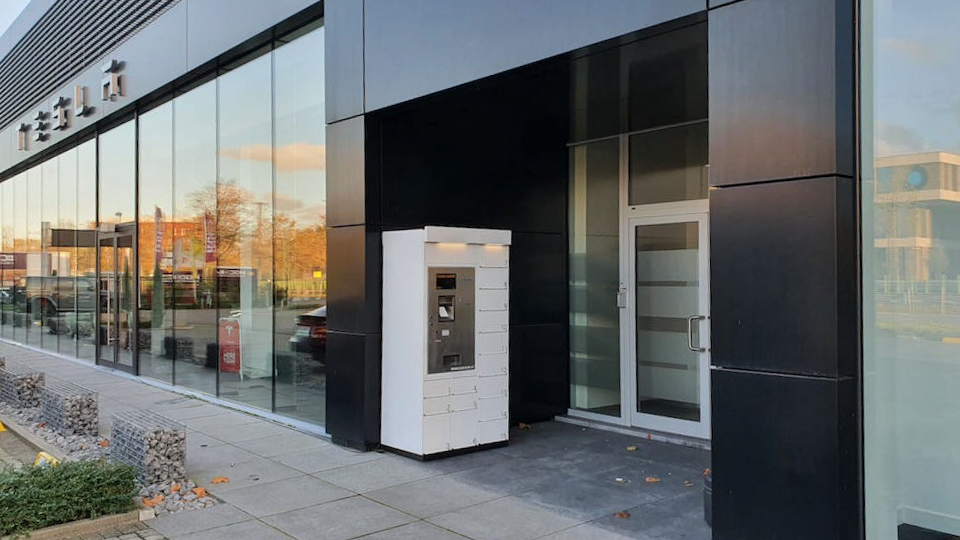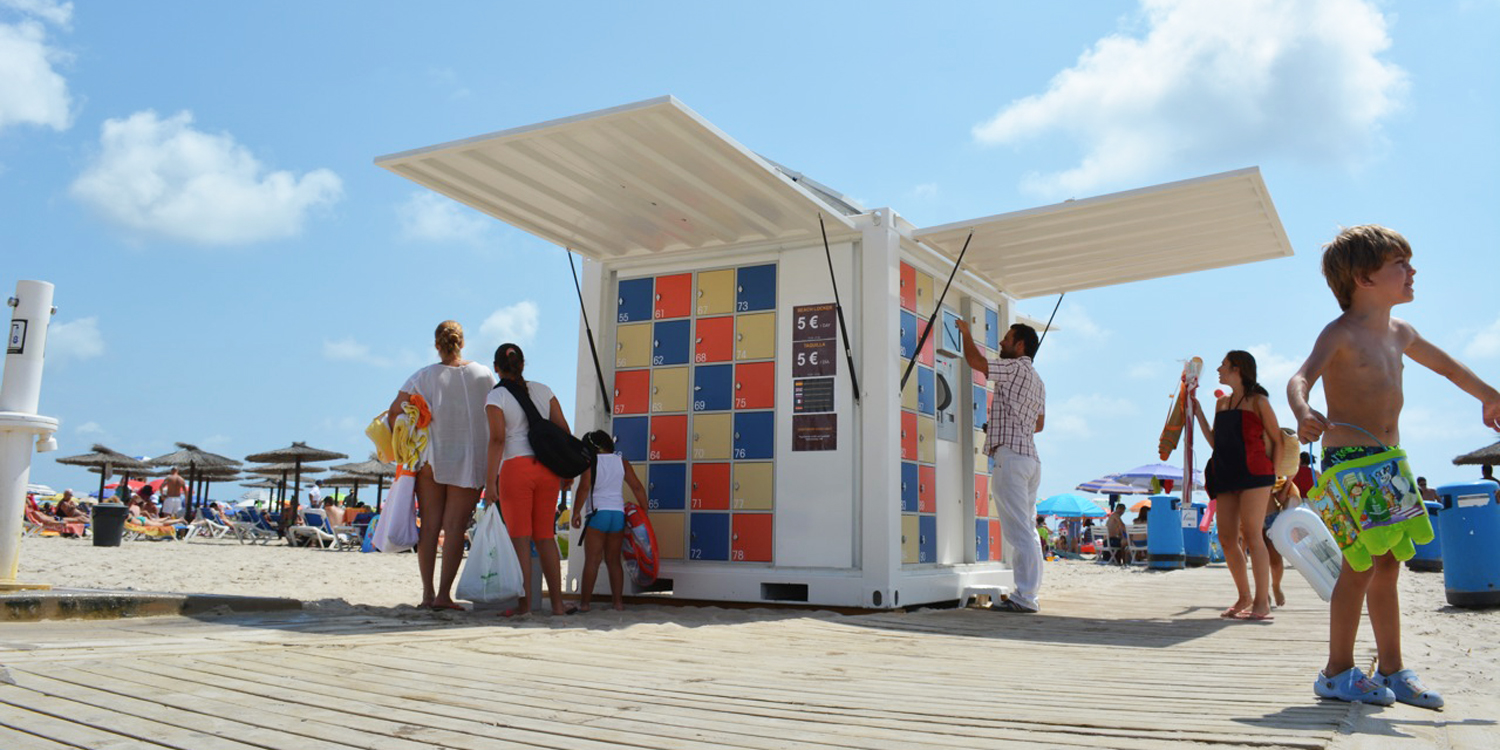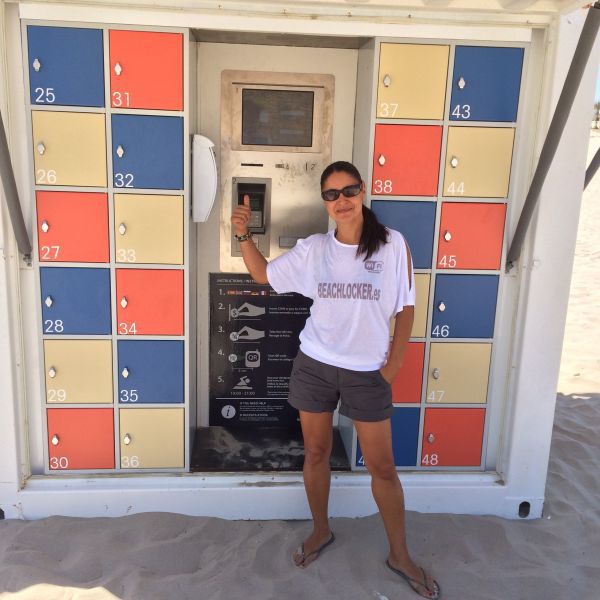ANYONE WHO HAS BEEN VISITING A FESTIVAL WILL UNDOUBTEDLY RECOGNIZE THE MOBILE LOCKER UNITS WITH THEIR BLUE, YELLOW AND RED COLORED DOORS. JEF VAN HYFTE AND KOEN MORTELMANS DEVELOPED THESE HIGH-TECHNOLOGICAL LOCKERS IN FLANDERS, BUT THEY ARE REQUESTED FAR BEYOND THE COUNTRY BORDERS.
Mobile Locker is an intelligent locker system: during events, it is monitored in real time exactly how many lockers have been rented and the capacity can be adjusted. There are units with solar panels that are self-sufficient in terms of electricity, users can charge their smartphones, enjoy WiFi and there are numerous payment options. Moreover, the units are plug-and-play, so organizers do not have to provide any infrastructure themselves, except for one power cable.
Jef Van Hyfte: “My wife and I were on the beach and we wanted to go swimming. To which she noted that a locker would be useful. There were wooden cabinets there at the time, but as a tourist you have little confidence in them. Suddenly a light went on and five minutes later I was on the phone with Koen.” “We had been working together at a marketing agency for about ten years,” continues Koen Mortelmans. “The collaboration was always good, so we decided to go for it.”
KAFKA ON THE BEACH
How did you turn the idea into a concrete plan? Koen Mortelmans: “We did market research on the beach: would people use it, how much would they be willing to pay for it… It turned out that tourists had much more confidence in an unmanned, robust locker for which you can pay with your bank card. Lockers were already there, of course, but they were not technological. Our concept took shape from our marketing background. We started from the idea that you can turn renting a locker into an experience. Then we built a prototype so we could test out our idea. It was a two-year process before we finalized that concept.” Jef Van Hyfte: “Getting a permit was difficult. So we took the plunge and placed the first prototype on a Spanish beach without a permit. The ministry and the police came to look at the test unit. Suddenly the idea became tangible for them, and a week later we had our permit in our pocket.” So you immediately targeted the Spanish costas? Koen Mortelmans: “That was the plan. But getting that idea off the ground was more difficult than expected.” Jef Van Hyfte: “It was a real battle against bureaucracy. On such a beach you are subject to many different regulations at the same time: European, national, municipal, port regulations, etc. Moreover, you have to contact each municipality separately. We learned valuable lessons from that first test. The product had a lot of potential, but the Spanish market was not ready for it at the time. So we started Mobile Locker in Belgium, but not on the coast.”
FROM THE COAST TO THE FESTIVAL MEADOW
When did Mobile Locker gain momentum? Jef Van Hyfte: “Our lockers turned out to be perfect for other market segments such as the events sector. The major festival organizers themselves approached us to place the units on the festival grounds and campsites. We then promptly built 9 prototypes. That was a process of trial and error. After all, we had no technological background at all, we were really catapulted into it. With the help of some local partners, we developed the software and built the housing. In one year we captured 80% of the festival market in our own country. Events are still our most important sales market and our product is fully tailored to them. In the meantime, other sales markets are also accelerating growth.” How did you raise the necessary funding? Koen Mortelmans: “The first investment to develop the prototypes came via a family loan.” Jef Van Hyfte: “Back in our own country, we started Mobile Locker with investments from Flemish business angels. This was followed by further capital rounds, including a crowd loan via Bolero. We raised 300,000 euros in three days.”
INTELLIGENT SOFTWARE
How do your lockers differ from what is already available on the market? Koen Mortelmans: “The combination of the intelligent software and the mobile aspect is unique. The software is also state of the art, with a range of options. We look at what is needed for each location and adjust the units accordingly. We can integrate extras, such as cashless payment with wristbands or access with palm recognition. The organizer can always monitor in real time how many lockers have been rented and adjust the capacity if necessary.” Jef Van Hyfte: “We also distinguish ourselves with our service. We deliver the lockers ready-made and arrange everything from A to Z. Our customer does not have to provide any infrastructure, other than a power cable. The payment system, the SIM card for the WiFi… We take care of all that.” They are intelligent lockers, do they also generate data? Jef Van Hyfte: “That possibility is there, but that’s it for now. The data we collect is completely anonymized and serves to map the occupancy. This way, organizers know exactly how many lockers have been rented, but we know nothing about our users. The legislative framework is becoming increasingly strict, so we do not think it is worth investing in it now. For example, in the future we could develop an app, but at events we work with peak times where things have to go quickly. Then there is no time to opt-in. Moreover, we are still too small-scale to do anything interesting with that data.” What does your competitive field look like? Jef Van Hyfte: “The competition is different for every sector. We have a very flexible product, so we reach different market segments. There is a huge market for lockers for festivals in the Netherlands, but the technology is outdated. We are a forerunner there. For the permanent lockers you have 101 players. They are focusing very hard on parcel delivery, but that is not our focus. So we don’t really consider those companies as competition.”
ADDED VALUE FOR SECURITY
How do you tap into new market segments? Jef Van Hyfte: “Once you have a reference project, you can develop a network and also offer your product within other segments. We have example projects in amusement parks, airports and music arenas. We also have a first reference in a hotel in Dublin, where our lockers fit perfectly into the automation that is continuing in that sector. There is also a lot of potential in high-traffic locations such as airports and train stations. Our plug-and-play lockers offer enormous flexibility. The airport sector is a bit more cautious, especially in Europe. Safety is an additional sensitivity there. For the airports you have to attend trade fairs and develop a network. But once you have shown how the lockers work exactly, they see that the picture is correct.” How do you deal with that safety aspect? Jef Van Hyfte: “The location of the lockers has a major impact on safety. Because our units are mobile, we can adapt to the safety regulations of the location.” Koen Mortelmans: “This does not only apply to airports, but also to football stadiums and large music venues such as the Sportpaleis. Large events increasingly work with a security circle, with locker units placed both inside and outside the security perimeter. Objects that are prohibited indoors are then placed in our locker blocks. In this way we relieve the burden on security staff.”
IN EUROPE AND FAR BEYOND
When did you look abroad again? Koen Mortelmans: “Our original idea was to place lockers on beaches, but that market is of course far too small in our own country. So from day one we focused abroad.” Jef Van Hyfte: “The Belgian festival market was the litmus test, but our lockers are already at more than 250 events throughout Europe. All leads come in through the website, and 99% of them are international.” What are the most important markets abroad? Jef Van Hyfte: “You can find our lockers at festivals throughout Europe, from France to the UK and Poland. The key now lies in finding local partners in all those countries so that we can expand into other market segments. We currently have an agent in Switzerland, Poland and the UK. Next year Italy, Spain and the Scandinavian countries will be added. Outside Europe, we are mainly active in Chile, but this has been delayed due to social unrest. We have also carried out projects in Hawaii and the Caribbean, for example. Koen Mortelmans: “The interesting thing about Chile is that we are on the beach there in the summer and in the ski resorts in the winter. This way you have a target audience almost all year round. We hope to do the same on the Côte d’Azur, in Cannes for example. But that is a bit more difficult. Outside Europe, the legislation is often simpler and everything happens faster.”
FLEMISH REPUTATION IN LATIN AMERICA
What have been the biggest stumbling blocks in the internationalization of Mobile Locker so far? Jef Van Hyfte: “Chauvinism! Particularly in France and Italy, business is mainly done with local companies. We have neither the time nor the network to arrange everything abroad ourselves. Our product is unique, now it is important to find a good local partner in every country. You notice that Flanders is a region with a good reputation. And that opens doors, especially in Latin America.” Are the lockers made in Flanders? Jef Van Hyfte: “Absolutely. The parts are Flemish, the units are assembled here in Antwerp and we install the fully Flemish software. We have strong software and manufacturing companies that are able to flexibly respond to the unique needs of our customers. Our lockers also provide local technology companies with a practical application for which they can develop innovations.”
CAPITALIZING OPPURTUNITIES
To what extent do you rely on FIT? Koen Mortelmans: “We contact you about four times a year for subsidies. The foundation with our contacts in Chile has also been laid through an economic representative of FIT.” Jef Van Hyfte: “FIT is also very important in support. When I was in Paris on a mission with Agoria, I was invited to the Ministry of Defense in connection with the Olympic Games. I contacted FIT, and they immediately sent someone to negotiate and translate. FIT’s network is also very valuable for trade fairs.” Koen Mortelmans: “Scholarships are very expensive, but they do give start-ups an enormous incentive and the necessary credibility. If you invest in an exhibition stand, it is important that you make a good impression. It is sometimes underexposed, but FIT is a very valuable partner to support young companies at trade fairs. Finally, what are your ambitions for the next five years? Koen Mortelmans: “To be recognized by every resident of Europe, that is the goal. Thanks to our presence at the festivals, we quickly build brand awareness. People recognize our lockers and have confidence in them, because they know that the system works. In recent years we have aimed very broadly, in the coming years it will mainly be a matter of focus: which segments do we want to focus on further? We have a unique product, now it is up to us to capitalize on our opportunities.”
https://view.publitas.com/flanders_investment_trade/wereldwijs-januari-2020/page/4-5





